Gerd Sieben Janssen
Gerd Sieben Janssen (born October 21, 1802 in Esens , † March 4, 1899 in Aurich ) was an East Frisian organ builder from Aurich. 16 new organs by him have been proven, some of which are still well preserved, especially those in Asel and Eggelingen .
Life
Gerd Sieben Janssen was born in 1802 as the son of master tailor Ihno Janssen (May 19, 1769 to 1853/55) and his wife Jurke Margaretha Gattena (May 3, 1768 to May 18, 1847) in Esens. His ancestors can be traced back to Esens over three generations. At least two of the seven siblings died early. After completing his apprenticeship as a carpenter, he learned organ building from Johann Gottfried Rohlfs and probably worked there as a journeyman between 1820 and 1823. After the military service, seven years of wandering abroad followed in order to deepen himself in organ and piano building. On April 1, 1833, he acquired citizenship in Esens, settled there as an instrument maker and married Dorothea Nessina Neessen (born March 2, 1803) on May 4, 1833, who died of a stillbirth on March 9, 1834. Janssen then moved to Aurich, where he set up his workshop and in 1835 married Margaretha Helena Hinrichs from Aurich. Some of the eight children learned to build organs. His son Julius Hillard (January 20, 1847 to March 19, 1925) took over the repairs and maintenance services from around 1893 and continued his father's business until the First World War , but did not build a new building himself. In terms of craftsmanship, Gerd Sieben Janssen worked traditionally and stood in the continuity of baroque organ building. It followed the high point of East Frisian organ culture in the 18th century, but could no longer maintain the level of Hinrich Just Müller and Johann Friedrich Wenthin . Janssen died at the old age of 96.
List of works
In the fifth column, the Roman number denotes the number of manuals , a capital "P" denotes an independent pedal , a small "p" denotes an attached pedal and the Arabic number in the penultimate column denotes the number of sounding registers .
| year | place | church | image | Manuals | register | Remarks |
|---|---|---|---|---|---|---|
| 1836-1838 | Aurich | reformed Church |
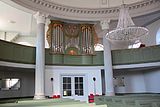
|
I / P | 11 | About 35 pipes and prospectus received; Extension and reconstruction 2003 (II / P / 18) |
| 1839-1840 | Tergast | Tergaster Church | I / p | 7th | Originally built for Neustadtgödens ; Transferred to Tergast in 1939; 1999–2000 partial reconstruction | |
| 1843? -1845 | Larrelt | Larrelter Church |

|
I / p | 11 | Reconstruction of the organ by Johannes Millensis (1618–19) |
| 1843-1846 | Eggelingen | St. George Church |
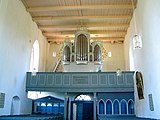
|
I / p | 8th | Largely preserved |
| around 1850 | Hollen | Christ Church |

|
I / p | 8th | 1896 sold to Warsingsfehn in the course of the rebuilding of the church; Hauptwerk case preserved (photo shows the later expanded organ in Warsingsfehn) |
| 1851 | Westrhauderfehn | Hope Church |

|
II / P | 22nd | Middle section preserved, registers almost completely replaced |
| 1854 | Pilsum | Pilsum Kreuzkirche |
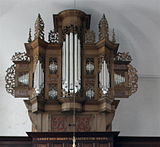
|
II / p | 16 | Reconstruction of the organ by Valentin Ulrich Grotian (1694) |
| 1854 | Grotegaste | St. John Baptist | II / P | 12 | Housing received | |
| 1854-1855 | Esklum | Esklumer Church |

|
I / p | 7th | Prospectus with 19 pipes received |
| 1855-1856 | Asel | St. Dionysius Church |
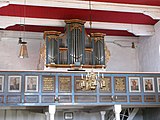
|
I / P | 8th | Housing (without prospectus pipes) and three registers partially preserved |
| 1858-1859 | Steenfelde | Steenfeld Church |

|
I / p | 9 | Prospectus received |
| 1857-1861 | Pewsum | Nicolai Church |
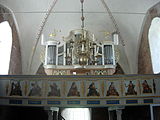
|
II / P | 16 | Prospectus received in Westeraccum (picture) |
| 1862-1864 | Etzel | St. Martinus Church |

|
II / p | 13 | Housing received |
| 1865 | Jheringsfehn | Jheringsfehner Church |

|
II / P | 15th | Housing and partly pipework preserved |
| 1867 | Potshausen | St. Martin Church | I / p | 8th | Not received | |
| 1869 | Full | Peter and Paul Church | I / P | 10 | Reconstruction of the organ by Wilhelm Eilert Schmid (1822–23); largely preserved | |
| 1874? | Breinermoor | St. Sebastian and St. Vincenz Church | I / P | 9 | Housing and partly pipework preserved | |
| 1877-1878 | Berdum | Mary Magdalene |
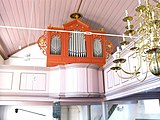
|
II / p | 9 | Built with his sons; In the 1960s, the wooden register, action and some of the case disintegrated due to worm infestation; 1977 reduction of manual to I / p / 5 as an emergency solution; one register replaced, otherwise preserved |
| 1878 | Wiegboldsbur | Wibadi Church |

|
I / P | 8th | Reconstruction of the organ by Wilhelm Eilert Schmid (1818–19); largely preserved |
| 1883-1884 | Big wolves | Großwolder Church |
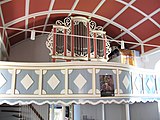
|
I / p | 8th | Replaced by Furtwängler & Hammer in 1919 , brochure preserved |
See also
literature
- Ev.-ref. Parish Aurich (Hrsg.): Organ town Aurich . Self-published, Aurich 2003.
- Hermann Fischer : 100 years of the Association of German Organ Builders . Orgelbau-Fachverlag, Lauffen 1991, ISBN 3-921848-18-0 .
- Walter Kaufmann : The organs of East Frisia . East Frisian Landscape, Aurich 1968.
- Harald Vogel , Günter Lade, Nicola Borger-Keweloh: Organs in Lower Saxony . Hauschild Verlag , Bremen 1997, ISBN 3-931785-50-5 .
- Harald Vogel, Reinhard Ruge, Robert Noah, Martin Stromann: Organ landscape Ostfriesland . 2nd Edition. Soltau-Kurier-Norden, Norden 1997, ISBN 3-928327-19-4 .
Web links
- Wolfgang Henninger: Gerd Sieben Janssen (PDF; 56 kB). In: Biographical Lexicon for East Frisia . Volume 3. Aurich 2001, pp. 213-215.
Individual evidence
| personal data | |
|---|---|
| SURNAME | Janssen, Gerd Sieben |
| BRIEF DESCRIPTION | East Frisian organ builder |
| DATE OF BIRTH | October 21, 1802 |
| PLACE OF BIRTH | Esens |
| DATE OF DEATH | March 4, 1899 |
| Place of death | Aurich |



